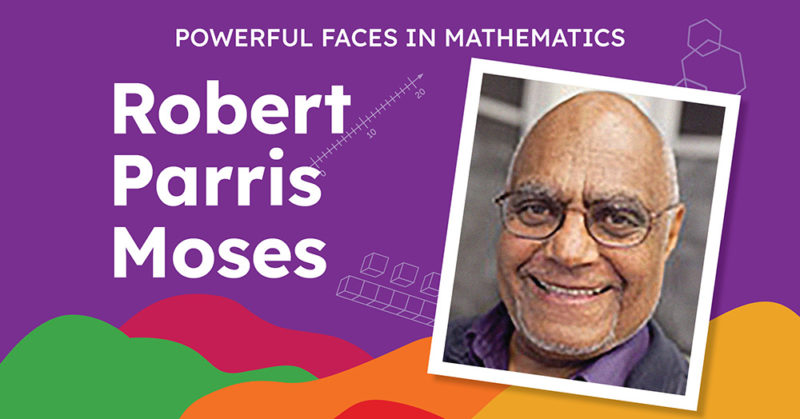Mathematicians
Powerful Faces in Mathematics: Robert Parris Moses
Robert Parris Moses (better known as Bob Moses) is a name many people in the mathematical world are familiar with. Bob Moses was a mathematician, an activist, a teacher, a husband, a father, a community leader, and a man of action. That last statement is one that needs to be emphasized; he was at his core, a man of action. How many of us have found ourselves in a situation regarding something at work, something at our children’s school, something at the store, really anywhere that we see an opportunity for change, but we do nothing about it? We all like to solve the world’s problems silently, to our partners or friends, over a glass of soda or bottle of wine, ‘you know what they should do? …’ but inertia prevails. Newton sums it up perfectly, “an object at rest will remain at rest, or an object in motion will remain in motion until acted upon by an unbalanced force.” Those words exemplify Moses until his death last year (2021) at 86 years old, Moses was one who never faltered in his journey in activism or mathematics.
Moses grew up in Harlem, New York to parents who knew that a good education would lead him to a better life. With their support, Moses studied at Stuyvesant High School and matriculated Hamilton College where he completed his BA in Philosophy in 1956. Immediately, he was on to Harvard to complete a Master’s Degree in Philosophy (he would return to Harvard years later to earn his PH.D. in Philosophy of Mathematics). In 1958, Moses took teaching jobs in the Bronx, but it didn’t take long until he was called to action and made his way to Mississippi to join the Civil Rights Movement and help register Black Americans to vote.
It was there, in Mississippi in 1960, where he met Ella Baker, the woman who would become his mentor and help sculpt his future activism. Baker helped establish the Student Nonviolent Coordinating Committee (SNCC) and ran the organization as ‘group-centered leadership’. Moses was immediately taken by Baker’s belief that leadership should starts at the bottom, on a local and community level, before it could go to the top. Together they helped develop leaders by giving them community support, values and missions, a sense of responsibility, and a platform from which to be heard. At the time, Blacks, and other people of color, were required to pass literacy tests in order to register to vote; Moses took the bold step of recruiting white students to assist teaching literacy to those potential voters. Over the next five years, Moses was instrumental in signing up thousands of Black voters; and in his ’spare’ time also founded the Freedom Summer Project and the Mississippi Freedom Democratic Party. In 1965, the hard work of Moses and his fellow activist paid off and the Voting Rights Act was passed. This ended the use of those literacy tests in the South and the rest of the country soon followed suit.
Following his success in Mississippi activism, Moses grew active in the movement against the Vietnam War and spoke at several protests before moving his family to Tanzania, East Africa to focus on his other passion, mathematics. In Tanzania, Moses taught mathematics for nearly ten years before he eventually decided to settle in Massachusetts (MA) to finish his Ph.D. at Harvard. It would be a few more years until one of his greatest known movements, The Algebra Project, would come into existence.
The Algebra Project came about authentically. In 1982, Moses’ eldest child was entering the 8th grade at her school in Cambridge, MA, a school which did not offer algebra. Without algebra, Moses knew that his daughter would not have the necessary credits necessary to enter Honors math and science classes in high school. And so, Moses worked with his daughter’s teacher to provide supplemental math lessons to her, and a handful of other students, who went on to pass the citywide algebra exam, receiving the necessary qualifications to enter AP classes her freshman year. And so, the Algebra Project was born.
The Algebra Project was founded on Moses’ belief that a quality education was a constitutional right. “I believe that the absence of math literacy in urban and rural communities throughout this country is an issue as urgent as the lack of registered Black voters in Mississippi was in 1961,” he wrote. He wanted Black and underserved or marginalized children to learn to solve problems and relate math to their everyday lives. “Math literacy will be a liberation tool for people trying to get out of poverty and the best hope for people trying not to get left behind.” Moses continued.
The Algebra Project is a teaching philosophy that moves students through the following five steps: direct experience (tactile objects and manipulatives), pictorial representation, intuitive expression (explain it in your own words), structured expression, and symbolic representation. Students do this together, which harkens back on the SNCC philosophy of ‘group-centered leadership’ where the students work together and share the experience of problem solving and being dependent on one another.
Today, The Algebra Project is still active in its mission to achieve math equality, and it also has an offspring nonprofit, the Young Peoples Project.
So next time you find yourself hemming and hawing about an injustice or unfortunate circumstance, be that unbalanced force, for an object at rest will remain so until … well you know the rest.
Sources:
https://www.penguinrandomhouse.com/books/206027/radical-equations-by-robert-p-moses/
https://www.yesmagazine.org/social-justice/2021/07/30/civil-rights-bob-moses-algebra-project



